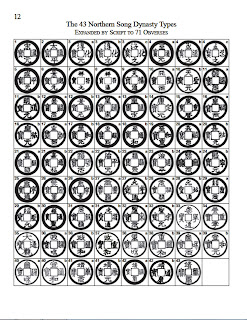Published April 6, 2016. First copy received today, April 13, 2016.
SPECIFICATIONS
Language:
English / Chinese
Pages:
288
Cover:
Glossy card stock
Binding:
Coil
Interior:
Black and white
Dimensions:
8.5" x 11" / 22 x 28 cm
Weight:
1.89 lbs / 0,857 kg
Shipping weight:
3 lbs / 1,36 kg
This is not only a new edition of my original catalogs, which were issued as 40 page stapled journals in six volumes, but a complete revision.
What has stayed the same?
— The variety numbers have not changed for any types that have been included.
What has changed?
— Clear Times New Roman (for English) and Simsun (for Chinese) fonts are used to make reading easier.
— New Type numbers replace the Schjöth based type numbers.
— The new Type numbers are an example of a Universal Numbering System for Chinese Cash (UNS) which I propose to apply to all coins of all dynasties.
— Type tabs in a special tab section at the beginning of the catalog summarize all the details about each Type. The same tabs are used throughout the catalog as sidebars to indicate when a new Type is being treated.
— Reverse rubbings have been added for many varieties that were not shown before.
— Matching Cash are shown together, rather than separately by Style.
— A few Types have been removed as being fantasy issues.
— More descriptive detail has been added for many Types.
— Variety descriptions are now given in tables, with the English variety name first, followed by Chinese and pinyin.
— The one coin of the Later Zhou dynasty, Zhou Yuan Tong Bao, has been included as the forerunner to the Northern Song series.
— The undated coins of the Southern Song series, as well as those of the Jin and Western Xia dynasties have been omitted. These will appear in a new catalog covering them in full, Southern Song Dynasty Cash Variety Guide 2017.
— The few iron coins that were formerly included have been omitted, but references to what iron varieties exist is given for every Type, using the catalog
两宋铁钱 Liǎng Sòng Tiě Qián (2000), the best variety guide for iron coins of both Song dynasties, and giving both LSTQ numbers and their UNS equivalents.
— Table of emperors and eras has been added.
— Table of 48 dynasty codes has been added.
— Chinese and tone-marked pinyin texts have been added throughout the catalog. These may be skipped over in reading for those uninterested, but they also provide an easy way to acquire a reading knowledge of numismatic and historical Chinese for those interested.
— Map and descriptions of 89 mints operating in the Song era, in many cases with years of opening and closing.
A
VAILABILITY
Northern Song Dynasty Cash Variety Guide 2016 is available starting today.
It is available in two editions.
FIRST EDITION
ISBN 5800115830814
Copyright: 2016
Published: April 6, 2016
Language: English / Chinese
Pages: 288
Binding: (Plastic) Coil
Interior: Black and white
Weight: 1.89 lbs.
Dimensions (inches): 8.5 wide x 11 tall
Price:
$34.95 PPD (Media Mail) USA ONLY
TO ORDER Contact
Norman F. Gorny, email
normanfgorny@juno.com
COMMENT
This edition is the original edition that lies flat when open, so that the rubbings can be used as sorting grids.
Available NOW from the Author. Allow 2 weeks between order date and delivery.
BOOKSHELF EDITION
ISBN 9781365056055
Copyright: 2016
Published: April 18, 2016
Language: English / Chinese
Pages: 288
Binding: Perfect-bound
Interior: Black and white
Weight: 1.89 lbs.
Dimensions (inches): 8.5 wide x 11 tall
Price:
$29.95 Shipping Extra
TO ORDER Click on a Link below
Amazon
Lulu
COMMENT
This edition is a standard bound softcover book.
It is a POD (Print on demand) book, and is available worldwide through one of the publishing networks named above. Shipping cost and delivery time will vary, depending on vendor.
For some sample pages, see the next post.










































